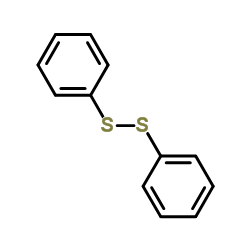Suppressing effects of S-methyl methanethiosulfonate and diphenyl disulfide on mitomycin C-induced somatic mutation and recombination in Drosophila melanogaster and micronuclei in mice.
Y K Nakamura, K Kawai, H Furukawa, T Matsuo, K Shimoi, I Tomita, Y Nakamura
文献索引:Mutat. Res. 385(1) , 41-6, (1997)
全文:HTML全文
摘要
S-Methyl methanethiosulfonate (MMTS) and diphenyl disulfide (DPDS) are temporary enzyme-sulfhydryl blocking agents. They are naturally occurring phytoalexin-like and synthetic substances known to be very potent bio-antimutagens in Escherichia coli B/r WP2. In the present paper, the suppressing effects of MMTS on mitomycin C (MMC)-induced mutant wing spots in the somatic mutation and recombination test (SMART) of Drosophila melanogaster, and of MMTS and DPDS on MMC-induced micronucleated peripheral reticulocytes are described. MMTS consistently reduced the numbers of MMC-induced small single, large single and twin spots per wing at a dose of 10-1000 micrograms/vial, in a dose-dependent manner. MMTS reduced the number of twin spots per wing on the spontaneous mutation at the dose of 1000 micrograms/vial. MMTS and DPDS dose-dependently reduced the frequencies of MMC-induced micronucleated peripheral reticulocytes at a dose of 10-40, and 3-100 micrograms/kg, respectively. Our results confirmed that enzyme-sulfhydryl blocking agents, such as MMTS and DPDS, are effective antimutagens in vivo too.
相关化合物
| 结构式 | 名称/CAS号 | 分子式 | 全部文献 |
|---|---|---|---|
 |
二苯二硫醚
CAS:882-33-7 |
C12H10S2 |
|
Targeting the fatty acid biosynthesis enzyme, beta-ketoacyl-...
2009-02-26 [J. Med. Chem. 52 , 952-63, (2009)] |
|
The fate of diphenyl sulphide, diphenyl sulphoxide and diphe...
2000-01-01 [Drug Metabol. Drug Interact. 16(3) , 191-206, (2000)] |
|
Functional groups and sulfur K-edge XANES spectra: divalent ...
2010-09-09 [J. Phys. Chem. A 114(35) , 9523-8, (2010)] |
|
Reductive addition of the benzenethiyl radical to alkynes by...
2009-08-06 [Org. Lett. 11(15) , 3298-301, (2009)] |
|
Molecular modeling and enzyme kinetics indicate a novel mech...
1987-01-01 [Adv. Prostaglandin. Thromboxane. Leukot. Res. 17A , 69-74, (1987)] |